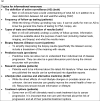Informational needs during active surveillance for prostate cancer: A qualitative study
- PMID: 28886974
- PMCID: PMC5808852
- DOI: 10.1016/j.pec.2017.08.022
Informational needs during active surveillance for prostate cancer: A qualitative study
Abstract
Objective: To understand the informational needs during active surveillance (AS) for prostate cancer from the perspectives of patients and providers.
Methods: We conducted seven focus groups with 37 AS patients in two urban clinical settings, and 24 semi-structured interviews with a national sample of providers. Transcripts were analyzed using applied thematic analysis, and themes were organized using descriptive matrix analyses.
Results: We identified six themes related to informational needs during AS: 1) more information on prostate cancer (biopsy features, prognosis), 2) more information on active surveillance (difference from watchful waiting, testing protocol), 3) more information on alternative management options (complementary medicine, lifestyle modification), 4) greater variety of resources (multiple formats, targeting different audiences), 5) more social support and interaction, and 6) verified integrity of information (trusted, multidisciplinary and secure).
Conclusions: Patients and providers described numerous drawbacks to existing prostate cancer resources and a variety of unmet needs including information on prognosis, AS testing protocols, and lifestyle modification. They also expressed a need for different types of resources, including interaction and unbiased information.
Practical implications: These results are useful to inform the design of future resources for men undergoing AS.
Keywords: Active surveillance; Digital media; Informational needs; Prostate cancer; Qualitative research.
Copyright © 2017 Elsevier B.V. All rights reserved.
Figures


References
-
- Klotz L, et al. Long-term follow-up of a large active surveillance cohort of patients with prostate cancer. J Clin Oncol. 2015;33(3):272–7. - PubMed
-
- Ganz PA, et al. National Institutes of Health State-of-the-Science Conference Statement: Role of Active Surveillance in the Management of Men with Localized Prostate Cancer. NIH Consens State Sci Statements. 2011;281(1):1–27. - PubMed
-
- Davison BJ, et al. Factors influencing men undertaking active surveillance for the management of low-risk prostate cancer. Oncol Nurs Forum. 2009;36(1):89–96. - PubMed
Publication types
MeSH terms
Grants and funding
LinkOut - more resources
Full Text Sources
Other Literature Sources
Medical
Research Materials

